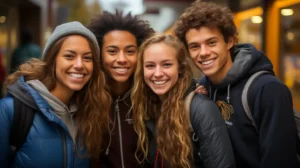Team-building exercises are crucial for encouraging communication and cooperation among high school students. These exercises help to dissolve barriers at the start of the academic year and improve problem-solving abilities as students collaborate to tackle obstacles. Given the mix of different personalities and ways of learning in a classroom, team-building activities serve to bring everyone together, closing divides and creating a feeling of unity.
Team Building Activities High School

I’ve observed that these activities stretch beyond mere fun and games; they teach students valuable life lessons in trust, leadership, and cooperation. They often require minimal resources, making them easy to implement in the classroom. They lay a strong foundation for students to handle collaborative projects with ease and grace, reflecting real-world scenarios they will undoubtedly encounter.
Fundamentals of Team Building in High School

In my experience, effective team building within high schools is essential for fostering a strong sense of community. When students engage in team-building activities, they develop crucial teamwork skills that are beneficial both inside and outside the classroom.
Key Aspects
- Communication: Clear and open dialogue is non-negotiable. I must encourage students to articulate their ideas and listen to others.
- Trust: Building trust among team members leads to a more cohesive community.
- Problem-Solving: When presented with challenges, a united team that can brainstorm and negotiate solutions is more efficient.
Here’s a simple breakdown of essential elements:
- Goals: Establishing common objectives is the first step I take. It provides direction and purpose.
- Roles: Clearly defined roles ensure that all students know what’s expected of them.
- Responsibility: Accountability for individual and group tasks reinforces the importance of each member’s contribution.
I focus on activities that require collaboration and often find that these can be more impactful than traditional classroom settings in developing a genuine community feel. I embrace a friendly approach, offering support and encouraging reflection on both the group’s successes and areas for improvement. Through sustained team-building efforts, I aim to help my students realize that everyone has an important part to play in the fabric of our school’s community.
Innovative Team Building Activities
In my experience, innovative team-building activities not only foster unity but also bring an element of fun to the learning environment. Here, I’ll share some engaging activities to help students collaborate and grow.
Physical Engagement and Sports
Physical activities are fantastic for team bonding among students. I like incorporating questions into a traditional relay race, where each teammate answers a question about themselves before passing the baton. Another idea is to organize sports teams for a friendly basketball or volleyball match, which can serve as a great bonding activity and an opportunity to promote healthy competition.
Classroom and Academic Exercises
I focus on activities that improve language learning and other academic skills in the classroom setting. A popular choice is a debate club; this encourages students to enhance their English language skills and articulate abilities. For younger classes, play-acting with puppets and realia can be a dynamic way to improve vocabulary and reading skills.
Creative and Interactive Activities
Creativity also plays a crucial role in team building. I love guiding students through storytelling activities where they can use visual aids to share stories and inspire one another. Also, icebreaker activities like ‘Two Truths and a Lie’ motivate students to learn interesting facts about their peers, framing the classroom as an array of unique narratives.
Exploratory and Problem-Solving Tasks
I’ve found that tasks that require students to collaborate on finding solutions can be very effective. Setting up a scavenger hunt around the school, with clues that push them to think critically or incorporate aspects of their subjects, can be a thrilling exploratory task. Another idea simulates a ‘Shark Tank’ scenario where teams must create and present a product or service. This can be a profound language learning tool as students practice pitching and negotiating in English.
What are some engaging activities for students during the final week of school?
Engaging activities for the last week can include Minute to Win It games, which test students’ coordination and speed in fun, one-minute challenges. Teachers may also organize themed days, such as beach, art, or sports days, to add variety to the final week.
How can teachers make the last week of school memorable for their students?
Teachers can create a graffiti wall where students can express themselves artistically, or they could stage a talent show to showcase the diverse talents of their classroom. Planning activities that allow students to reflect on the year and celebrate their achievements can make lasting memories.
Can you suggest no-prep activities that are perfect for the last day of school?
Activities such as a classroom awards ceremony or a memory signing session, where students and teachers can write notes to each other, are simple yet meaningful ways to conclude the school year without requiring extensive preparation.
If you enjoyed reading about Team Building Activities High School, check out our other articles:
- Student Council Event Ideas: Engaging and Fun Activities
- PTA Event Ideas: Fun and Engaging Activities for Your School Community
- School Event Ideas for Students: Create Unforgettable Memories
- School Event Ideas: Fun and Engaging Activities
- School Event Ideas for High School: Fun and Engaging Activities
Feel free to also check out our other Articles about School Events from the category “School Life“ and don’t forget to follow us on Pinterest.






